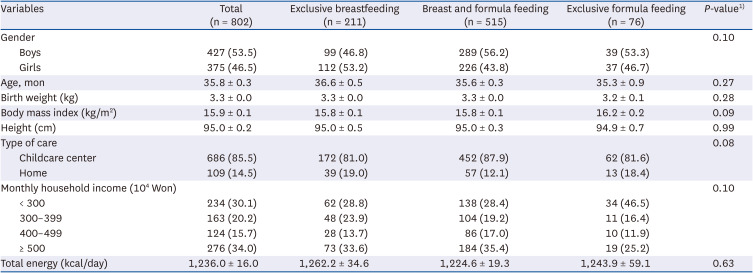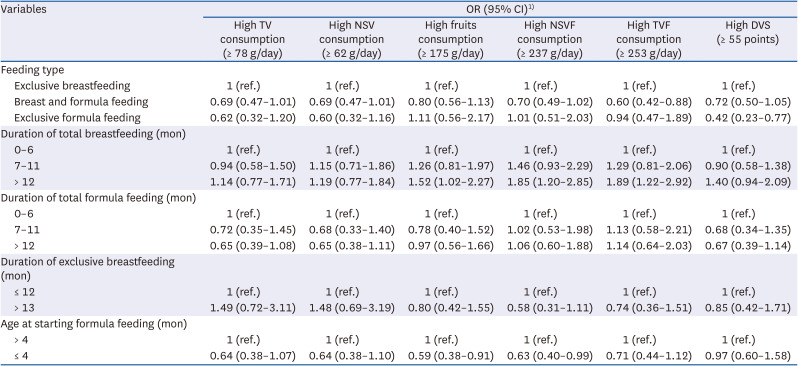1. Skinner JD, Carruth BR, Wendy B, Ziegler PJ. Children’s food preferences: a longitudinal analysis. J Am Diet Assoc. 2002; 102:1638–1647. PMID:
12449287.
2. Husk JS, Keim SA. Breastfeeding and dietary variety among preterm children aged 1-3 years. Appetite. 2016; 99:130–137. PMID:
26792771.
3. Han YJ, Lee JY. Effect of breast-feeding on the eating habits in late childhood of Korean pediatric and adolescent outpatients. J Korean Acad Breastfeed Med. 2016; 2:49–57.
4. Yoon HJ, Kim MH, Jang KH, Lee JH. Comparison of obesity level and eating habits according to intake experience of mother's milk and eating habits of baby foods by elementary school students. J Korean Soc Food Cult. 2014; 25:380–389.
5. Grimm KA, Kim SA, Yaroch AL, Scanlon KS. Fruit and vegetable intake during infancy and early childhood. Pediatrics. 2014; 134(Suppl 1):S63–S69. PMID:
25183758.
6. Scott JA, Chih TY, Oddy WH. Food variety at 2 years of age is related to duration of breastfeeding. Nutrients. 2012; 4:1464–1474. PMID:
23201765.
7. Oliveira A, Jones L, de Lauzon-Guillain B, Emmett P, Moreira P, Charles MA, Lopes C. Early problematic eating behaviours are associated with lower fruit and vegetable intake and less dietary variety at 4-5 years of age. A prospective analysis of three European birth cohorts. Br J Nutr. 2015; 114:763–771. PMID:
26195187.
8. Specht IO, Rohde JF, Olsen NJ, Heitmann BL. Duration of exclusive breastfeeding may be related to eating behaviour and dietary intake in obesity prone normal weight young children. PLoS One. 2018; 13:e0200388. PMID:
29995949.
9. Shim JE, Paik HY. Association between picky eating behaviors and growth in preschool children. J Nutr Health. 2013; 46:418–426.
10. Soldateli B, Vigo A, Giugliani ER. Effect of pattern and duration of breastfeeding on the consumption of fruits and vegetables among preschool children. PLoS One. 2016; 11:e0148357. PMID:
26844543.
11. Jones L, Moschonis G, Oliveira A, de Lauzon-Guillain B, Manios Y, Xepapadaki P, Lopes C, Moreira P, Charles MA, Emmett P. The influence of early feeding practices on healthy diet variety score among pre-school children in four European birth cohorts. Public Health Nutr. 2015; 18:1774–1784. PMID:
25409628.
12. Mennella JA, Lukasewycz LD, Castor SM, Beauchamp GK. The timing and duration of a sensitive period in human flavor learning: a randomized trial. Am J Clin Nutr. 2011; 93:1019–1024. PMID:
21310829.
13. Cooke LJ, Wardle J, Gibson EL, Sapochnik M, Sheiham A, Lawson M. Demographic, familial and trait predictors of fruit and vegetable consumption by pre-school children. Public Health Nutr. 2004; 7:295–302. PMID:
15003137.
14. Fortunato JE, Scheimann AO. Protein-energy malnutrition and feeding refusal secondary to food allergies. Clin Pediatr (Phila). 2008; 47:496–499. PMID:
18509149.
15. Mennella JA, Jagnow CP, Beauchamp GK. Prenatal and postnatal flavor learning by human infants. Pediatrics. 2001; 107:E88. PMID:
11389286.
16. Beauchamp GK, Mennella JA. Flavor perception in human infants: development and functional significance. Digestion. 2011; 83(Suppl 1):1–6.
17. Yon MY, Lee JY, Nam JW, Moon GI, Hong JH, Kim CI. Breast-feeding and obesity in early childhood - based on the KNHANES 2008 through 2011. Korean J Community Nutr. 2013; 18:644–651.
18. Bell LK, Jansen E, Mallan K, Magarey AM, Daniels L. Poor dietary patterns at 1-5 years of age are related to food neophobia and breastfeeding duration but not age of introduction to solids in a relatively advantaged sample. Eat Behav. 2018; 31:28–34. PMID:
30086453.
19. Bell S, Yew SS, Devenish G, Ha D, Do L, Scott J. Duration of breastfeeding, but not timing of solid food, reduces the risk of overweight and obesity in children aged 24 to 36 months: findings from an Australian cohort study. Int J Environ Res Public Health. 2018; 15:599. PMID:
29587447.
20. Mannan H. Early infant feeding of formula or solid foods and risk of childhood overweight or obesity in a socioeconomically disadvantaged region of Australia: a longitudinal cohort analysis. Int J Environ Res Public Health. 2018; 15:1685. PMID:
30087304.
21. Moschonis G, de Lauzon-Guillain B, Jones L, Oliveira A, Lambrinou CP, Damianidi L, Lioret S, Moreira P, Lopes C, Emmett P, et al. The effect of early feeding practices on growth indices and obesity at preschool children from four European countries and UK schoolchildren and adolescents. Eur J Pediatr. 2017; 176:1181–1192. PMID:
28711955.
22. Pearce J, Taylor MA, Langley-Evans SC. Timing of the introduction of complementary feeding and risk of childhood obesity: a systematic review. Int J Obes. 2013; 37:1295–1306.
23. Lee E, Choi HY, Heo YR. Intake of fruits and vegetables may modify the risk of cataract in Korean males. J Nutr Health. 2018; 51:423–432.
24. Kang MH, Kim HY, Kwon SH, Choi YS, Chung HR, Kwak TK, Cho YH. Selecting items of a food behavior checklist for the development of Nutrition Quotient (NQ) for children. Korean J Nutr. 2012; 45:372–389.
25. Schebendach JE, Mayer LE, Devlin MJ, Attia E, Contento IR, Wolf RL, Walsh BT. Dietary energy density and diet variety as predictors of outcome in anorexia nervosa. Am J Clin Nutr. 2008; 87:810–816. PMID:
18400701.
26. Lee M, Chae SW, Cha YS, Cho MS, Oh HY, Kim MK. Development of a Korean Diet Score (KDS) and its application assessing adherence to Korean healthy diet based on the Korean Food Guide Wheels. Nutr Res Pract. 2013; 7:49–58. PMID:
23424060.
27. Kim DY, Ahn A, Lee H, Choi J, Lim H. Dietary patterns independent of fast food are associated with obesity among Korean adults: Korea National Health and Nutrition Examination Survey 2010-2014. Nutrients. 2019; 11:2740. PMID:
31726687.
28. Lee JY, Lee S. Dietary patterns related to appendicular skeletal muscle mass: the Korea National Health and Nutrition Examination Survey 2008-2011. J Am Coll Nutr. 2019; 38:358–363. PMID:
30570371.
29. Barros L, Lopes C, Oliveira A. Child and family characteristics are associated with a dietary variety index in 4-year-old children from the Generation XXI cohort. Nutr Res. 2019; 63:76–85. PMID:
30824400.
30. Byrne R, Yeo ME, Mallan K, Magarey A, Daniels L. Is higher formula intake and limited dietary diversity in Australian children at 14 months of age associated with dietary quality at 24 months? Appetite. 2018; 120:240–245. PMID:
28899651.
31. Novaes JF, Lamounier JA, Colosimo EA, Franceschini SC, Priore SE. Breastfeeding and obesity in Brazilian children. Eur J Public Health. 2012; 22:383–389. PMID:
21616992.
32. Parsons TJ, Power C, Manor O. Infant feeding and obesity through the lifecourse. Arch Dis Child. 2003; 88:793–794. PMID:
12937101.
33. Savage JS, Fisher JO, Birch LL. Parental influence on eating behavior: conception to adolescence. J Law Med Ethics. 2007; 35:22–34. PMID:
17341215.
34. Forestell CA, Mennella JA. Early determinants of fruit and vegetable acceptance. Pediatrics. 2007; 120:1247–1254. PMID:
18055673.
35. Dubois L, Farmer AP, Girard M, Peterson K. Preschool children’s eating behaviours are related to dietary adequacy and body weight. Eur J Clin Nutr. 2007; 61:846–855. PMID:
17180152.







 PDF
PDF Citation
Citation Print
Print



 XML Download
XML Download